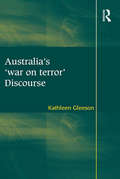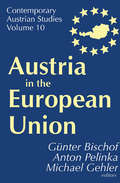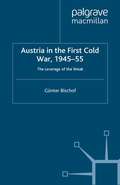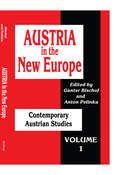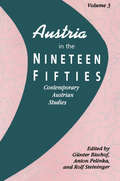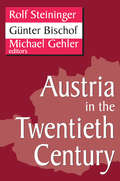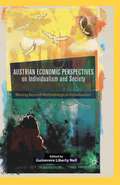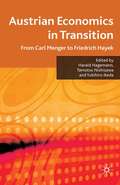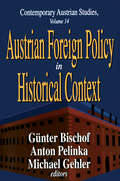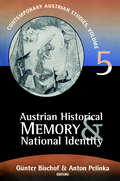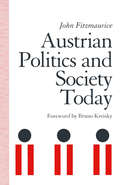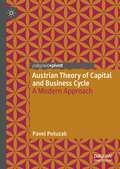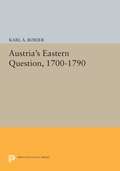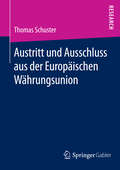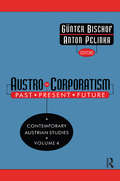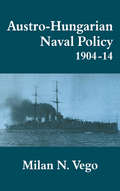- Table View
- List View
Australia's 'war on terror' Discourse
by Kathleen GleesonToo often, existing literature has conflated the discourses that enabled the 'War on Terror', ignoring the contextual specificities of the states that make up the ’Coalition of the Willing’. Australia's 'war on terror' Discourse fills this gap by providing a full and sustained critical analysis of Australian foreign policy discourse along with the theoretical synthesis for a specific model of critical discourse analysis of the subject. The language of then Prime Minister Howard is the primary focus of the book but attention is also paid to the language of key ministers, political opponents and other prominent actors. The voices of those who challenged the dominant discourse are also considered to shed light on the ways in which discourses can be destabilised. Kathleen Gleeson shows how Howard successfully invoked narratives of identity and sovereignty that resonated with his audience and promoted his reworked narrative of Australia whilst facing dissent from many actors who voiced their opposition most successfully when they capitalised on inconsistencies within the discourse.
Australia's 'war on terror' Discourse
by Kathleen GleesonToo often, existing literature has conflated the discourses that enabled the 'War on Terror', ignoring the contextual specificities of the states that make up the ’Coalition of the Willing’. Australia's 'war on terror' Discourse fills this gap by providing a full and sustained critical analysis of Australian foreign policy discourse along with the theoretical synthesis for a specific model of critical discourse analysis of the subject. The language of then Prime Minister Howard is the primary focus of the book but attention is also paid to the language of key ministers, political opponents and other prominent actors. The voices of those who challenged the dominant discourse are also considered to shed light on the ways in which discourses can be destabilised. Kathleen Gleeson shows how Howard successfully invoked narratives of identity and sovereignty that resonated with his audience and promoted his reworked narrative of Australia whilst facing dissent from many actors who voiced their opposition most successfully when they capitalised on inconsistencies within the discourse.
Austria in the European Union (Contemporary Austrian Studies #Vol. 10)
by Günter Bischof, Anton Pelinka, and Michael GehlerAustria joined the European Union in 1995, with the overwhelming support of its citizenry. In June 1994, a record 66.6 percent of the Austrian population voted in favor of joining the Union, and Austria acceded on January 1, 1995. Only three years later, in the second half of 1998, Austria assumed its first presidency of the European Union. Its competent conduct of the Union's business enhanced its reputation. The sense that Austria was a role model collapsed overnight, after a new conservative People's Party (iVP/FPi) coalition government was formed in Austria in early February 2000. Austria became Europe's nightmare.This volume has two purposes. The first is to assess Austria's first five years in the European Union. The second is Austria's ongoing struggle with its past. Heinrich Neisser evaluates and assesses Austria's commitment to the European Union. Thomas Angerer offers a long-term perspective of regionalization and globalization trends in Austrian foreign affairs. Waldemar Hummer analyzes contradictions between Austrian neutrality and Europe's emerging common security policy. Johannes Pollak and Sonja Puntscher Rieckmann look at current debates over weighing future voting rights in the European Commission. Michael Huelshoff evaluates Austria's EU presidency in 1998 and compares it to the subsequent 1999 German presidency. Gerda Falkner examines the withering away of the previously much admired Austrian welfare state. Walter Manoschek scrutinizes the Nazi roots of Jorg Haider's Freedom Party. Michael Gehler critiques the EU sanctions and bemoans the absence of mediation through transnational Christian conservative parties.In reviewing how Austria deals with World War II, Richard Mitten investigates discourses on victimhood in postwar Austria and the place of Jews in this process. A "Roundtable" presents overwhelming evidence of Austrians' deep involvement in Nazi war crimes, and includes articles by Sabine Loitfellner and Winfried Garscha. This addition to the Contemporary Austrian Studies series will be welcomed by political scientists, historians and legal scholars, particularly those with a strong interest in European affairs.
Austria in the European Union
by Anton PelinkaAustria joined the European Union in 1995, with the overwhelming support of its citizenry. In June 1994, a record 66.6 percent of the Austrian population voted in favor of joining the Union, and Austria acceded on January 1, 1995. Only three years later, in the second half of 1998, Austria assumed its first presidency of the European Union. Its competent conduct of the Union's business enhanced its reputation. The sense that Austria was a role model collapsed overnight, after a new conservative People's Party (iVP/FPi) coalition government was formed in Austria in early February 2000. Austria became Europe's nightmare.This volume has two purposes. The first is to assess Austria's first five years in the European Union. The second is Austria's ongoing struggle with its past. Heinrich Neisser evaluates and assesses Austria's commitment to the European Union. Thomas Angerer offers a long-term perspective of regionalization and globalization trends in Austrian foreign affairs. Waldemar Hummer analyzes contradictions between Austrian neutrality and Europe's emerging common security policy. Johannes Pollak and Sonja Puntscher Rieckmann look at current debates over weighing future voting rights in the European Commission. Michael Huelshoff evaluates Austria's EU presidency in 1998 and compares it to the subsequent 1999 German presidency. Gerda Falkner examines the withering away of the previously much admired Austrian welfare state. Walter Manoschek scrutinizes the Nazi roots of Jorg Haider's Freedom Party. Michael Gehler critiques the EU sanctions and bemoans the absence of mediation through transnational Christian conservative parties.In reviewing how Austria deals with World War II, Richard Mitten investigates discourses on victimhood in postwar Austria and the place of Jews in this process. A "Roundtable" presents overwhelming evidence of Austrians' deep involvement in Nazi war crimes, and includes articles by Sabine Loitfellner and Winfried Garscha. This addition to the Contemporary Austrian Studies series will be welcomed by political scientists, historians and legal scholars, particularly those with a strong interest in European affairs.
Austria in the First Cold War, 1945-55: The Leverage of the Weak (Cold War History)
by G. BischofAt the height of the first Cold War in the early 1950s, the Western powers worried that occupied Austria might become 'Europe's Korea' and feared a Communist takeover. The Soviets exploited their occupation zone for maximum reparations. American economic aid guaranteed Austria's survival and economic reconstruction. Their military assistance turned Austria into a 'secret ally' of the West. Austrian diplomacy played a vital role in securing the Austrian treaty in bilateral negotiations with Stalin's successors in the Kremlin demonstrating the leverage of the weak in the Cold War.
Austria in the New Europe (Contemporary Austrian Studies)
by Günter Bischof; Anton PelinkaFirst published in 1993, Contemporary Austrian Studies (CAS) is an academic publication appealing to a broad intellectual audience and fostering a multiplicity of views and perspectives. CAS's typical format features a number of essays on a special topic such as the impact of post-Cold War geopolitical developments and European integration on Austria in this issue (volume II will feature “A First Assessment of the Kreisky Era;” volume III will deal with “Austria in the 1950s”). Usually one or two “non-topical” essays will complete the main part.
Austria in the New Europe (Contemporary Austrian Studies)
by Anton Pelinka Gunter BischofFirst published in 1993, Contemporary Austrian Studies (CAS) is an academic publication appealing to a broad intellectual audience and fostering a multiplicity of views and perspectives. CAS's typical format features a number of essays on a special topic such as the impact of post-Cold War geopolitical developments and European integration on Austria in this issue (volume II will feature “A First Assessment of the Kreisky Era;” volume III will deal with “Austria in the 1950s”). Usually one or two “non-topical” essays will complete the main part.
Austria in the Nineteen Fifties
by Gunter BischofIn American history the 1950s are remembered as an affluent and harmonious decade. Not so in Austria. That nation emerged out of World War II with tremendous war-related destruction and with a four-power occupation that would last for ten years until 1955. Massive American economic aid enabled the Austrian economy to start recovering in the 1950s and reorient it from East to West. Unlike the United States, however, general affluence did not set in until the 1960s and 1970s even though Austria's dramatic baby boom enabled it to recover from the demographic catastrophe resulting from manpower losses of World War II., This volume deals with these larger trends. Stephen E. Ambrose discusses American-European relations and sets the larger international context for the Austrian scene. Oilver Rathkolb retraces the changing importance of the Austrian question for the Eisenhower administration. Michael Gehler presents an in-depth analysis of the intriguing question of whether Austria's unification at the price of permanent neutrality might have been a model for Germany. Franz Mathis and Kurt Tweraser look at economic reconstruction and the roles played by both the Austrian public industrial sector and the American Marshall Plan. Karin Schmidlechner looks at the youth culture of the era. Franz Adlgasser shows how Herbert Hoover's food aid was instrumental in the containment of communism in Hungary. Beth Noveck analyzes Austrian political culture of the First Republic from the perspective of Hugo Bettauer. Rolf Steininger presents an insightful historical overview of how the Austro-Italian South Tyrol conflict was resolved after seventy-five years of tension.
Austria in the Nineteen Fifties
by Anton Pelinka Günter BischofIn American history the 1950s are remembered as an affluent and harmonious decade. Not so in Austria. That nation emerged out of World War II with tremendous war-related destruction and with a four-power occupation that would last for ten years until 1955. Massive American economic aid enabled the Austrian economy to start recovering in the 1950s and reorient it from East to West. Unlike the United States, however, general affluence did not set in until the 1960s and 1970s even though Austria's dramatic baby boom enabled it to recover from the demographic catastrophe resulting from manpower losses of World War II., This volume deals with these larger trends. Stephen E. Ambrose discusses American-European relations and sets the larger international context for the Austrian scene. Oilver Rathkolb retraces the changing importance of the Austrian question for the Eisenhower administration. Michael Gehler presents an in-depth analysis of the intriguing question of whether Austria's unification at the price of permanent neutrality might have been a model for Germany. Franz Mathis and Kurt Tweraser look at economic reconstruction and the roles played by both the Austrian public industrial sector and the American Marshall Plan. Karin Schmidlechner looks at the youth culture of the era. Franz Adlgasser shows how Herbert Hoover's food aid was instrumental in the containment of communism in Hungary. Beth Noveck analyzes Austrian political culture of the First Republic from the perspective of Hugo Bettauer. Rolf Steininger presents an insightful historical overview of how the Austro-Italian South Tyrol conflict was resolved after seventy-five years of tension.
Austria in the Twentieth Century (Studies in Austrian and Central European History and Culture)
by Gino GermaniThese fourteen essays by leading Austrian historians and political scientists serve as a basic introduction to a small but sometimes trend-setting European country. They provide a basic up-to-date outline of Austria's political history, shedding light on economic and social trends as well. No European country has experienced more dramatic turning points in its twentieth-century history than Austria. This volume divides the century into three periods. The five essays of Section I deal with the years 1900-1938. Under the relative tranquility of the late Habsburg monarchy seethed a witch's brew of social and political trends, signaling the advent of modernity and leading to the outbreak of World War I and eventually to the collapse of the Habsburg Empire. The First Austrian Republic was one of the succession states that tried to build a nation against the backdrop of political and economic crisis and simmering civil war between the various political camps. Democracy collapsed in 1933 and an authoritarian regime attempted to prevail against pressures from Nazi Germany and Nazis at home. The two essays in Section II cover World War II (1938-1945). In 1938, Hitler's "Third Reich" annexed Austria and the population was pulled into the cauldron of World War II, fighting and collaborating with the Nazis, and also resisting and fleeing them. The seven essays of Section III concentrate on the Second Republic (1945 to the present). After ten years of four-power Allied occupation, Austria regained her sovereignty with the Austrian State Treaty of 1955. The price paid was neutrality. Unlike the turmoil of the prewar years, Austria became a "normal" nation with a functioning democracy, one building toward economic prosperity. After the collapse of the "iron curtain" in 1989, Austria turned westward, joining the European Union in 1995. Most recently, with the advent of populist politics, Austria's political system has experienced a sea of change departing from its political economy of a huge state-owned sector and social partnership as well as Proporz. This informed and insightful volume will serve as a textbook in courses on Austrian, German and European history, as well as in comparative European politics.
Austria in the Twentieth Century (Studies in Austrian and Central European History and Culture #Vol. 1)
by Gino GermaniThese fourteen essays by leading Austrian historians and political scientists serve as a basic introduction to a small but sometimes trend-setting European country. They provide a basic up-to-date outline of Austria's political history, shedding light on economic and social trends as well. No European country has experienced more dramatic turning points in its twentieth-century history than Austria. This volume divides the century into three periods. The five essays of Section I deal with the years 1900-1938. Under the relative tranquility of the late Habsburg monarchy seethed a witch's brew of social and political trends, signaling the advent of modernity and leading to the outbreak of World War I and eventually to the collapse of the Habsburg Empire. The First Austrian Republic was one of the succession states that tried to build a nation against the backdrop of political and economic crisis and simmering civil war between the various political camps. Democracy collapsed in 1933 and an authoritarian regime attempted to prevail against pressures from Nazi Germany and Nazis at home. The two essays in Section II cover World War II (1938-1945). In 1938, Hitler's "Third Reich" annexed Austria and the population was pulled into the cauldron of World War II, fighting and collaborating with the Nazis, and also resisting and fleeing them. The seven essays of Section III concentrate on the Second Republic (1945 to the present). After ten years of four-power Allied occupation, Austria regained her sovereignty with the Austrian State Treaty of 1955. The price paid was neutrality. Unlike the turmoil of the prewar years, Austria became a "normal" nation with a functioning democracy, one building toward economic prosperity. After the collapse of the "iron curtain" in 1989, Austria turned westward, joining the European Union in 1995. Most recently, with the advent of populist politics, Austria's political system has experienced a sea of change departing from its political economy of a huge state-owned sector and social partnership as well as Proporz. This informed and insightful volume will serve as a textbook in courses on Austrian, German and European history, as well as in comparative European politics.
Austrian Economic Perspectives on Individualism and Society: Moving Beyond Methodological Individualism
by Guinevere Liberty NellCan we improve upon both the free market and nationalization? Market socialist and other heterodox exploration of cultural and social factors can help answer this question using Austrian economic theory. This volume brings together economists and political scientists specializing in evolutionary change and spontaneous order. Spontaneous order and other Austrian theories are complemented by the consideration of cultural, social and communal interaction. Austrian Economic Perspectives on Individualism and Society bridges the gap between free market advocates stressing individual rights and individualistic culture, and left-leaning thinkers who stress social justice and a culture of social solidarity, or collectivism.
Austrian Economics in Transition: From Carl Menger to Friedrich Hayek
by H. Hagemann T. Nishizawa Y. IkedaThis book analyzes both the consistent and changing elements in the Austrian School of Economics since its foundation in the late 19th Century up to the recent offspring of this School. It investigates the dynamic metamorphosis of the school, mainly with reference to its contact with representatives of history of economic thought.
Austrian Foreign Policy in Historical Context
by Anton Pelinka Gunter Bischof Michael GehlerIn 2005, Austria celebrated the sixtieth anniversary of its liberation from the Nazi regime and the fiftieth anniversary of the State Treaty that ended the occupation and returned full sovereignty to the country. This volume of Contemporary Austrian Studies covers foreign policy in the twentieth century. It offers an up-to-date status report of Austria's foreign policy trajectories and diplomatic options. Eva Nowotny, the current Austrian ambassador to the United States, introduces the volume with an analysis of the art and practice of Austrian diplomacy in historical perspective. Ambassador Wolfgang Petritsch analyzes recent Balkans diplomacy as an EU emissary in the Bosnian and Kosovo crises. Historians G nther Kronenbitter, Alexander Lassner, G nter Bischof, Joanna Granville, and Martin Kofler provide historical case studies of pre-and post-World War I and World War II Austrian diplomacy, Austria's dealings with the Hungarian crisis of 1956, and its mediation between Kennedy and Khrushchev in the early 1960s. Political scientists Romain Kirt, Stefan Mayer, and Gunther Hauser analyze small states' foreign policymaking in a globalizing world, Austrian federal states' separate regional policy initiatives abroad and Austria's role vis-is current European security initiatives. Michael Gehler periodizes post-World War II Austrian foreign policy regimes and provides a valuable summary of both the available archival and printed diplomatic source collections. A "Historiography Roundtable" is dedicated to the Austrian Occupation decade. G nter Bischof reports on the state of occupation historiography; Oliver Rathkolb on the historical memory of the occupation; Michael Gehler on the context of the German question; and Wolfgang Mueller and Norman Naimark on Stalin's Cold War and Soviet policies towards Austria during those years. Review essays and book reviews on art theft, anti-Semitism, the Hungarian crisis of 1956, among other topics, complete the volume.
Austrian Foreign Policy in Historical Context (Contemporary Austrian Studies #Vol. 14)
by Anton Pelinka Gunter Bischof Michael GehlerIn 2005, Austria celebrated the sixtieth anniversary of its liberation from the Nazi regime and the fiftieth anniversary of the State Treaty that ended the occupation and returned full sovereignty to the country. This volume of Contemporary Austrian Studies covers foreign policy in the twentieth century. It offers an up-to-date status report of Austria's foreign policy trajectories and diplomatic options. Eva Nowotny, the current Austrian ambassador to the United States, introduces the volume with an analysis of the art and practice of Austrian diplomacy in historical perspective. Ambassador Wolfgang Petritsch analyzes recent Balkans diplomacy as an EU emissary in the Bosnian and Kosovo crises. Historians G nther Kronenbitter, Alexander Lassner, G nter Bischof, Joanna Granville, and Martin Kofler provide historical case studies of pre-and post-World War I and World War II Austrian diplomacy, Austria's dealings with the Hungarian crisis of 1956, and its mediation between Kennedy and Khrushchev in the early 1960s. Political scientists Romain Kirt, Stefan Mayer, and Gunther Hauser analyze small states' foreign policymaking in a globalizing world, Austrian federal states' separate regional policy initiatives abroad and Austria's role vis-is current European security initiatives. Michael Gehler periodizes post-World War II Austrian foreign policy regimes and provides a valuable summary of both the available archival and printed diplomatic source collections. A "Historiography Roundtable" is dedicated to the Austrian Occupation decade. G nter Bischof reports on the state of occupation historiography; Oliver Rathkolb on the historical memory of the occupation; Michael Gehler on the context of the German question; and Wolfgang Mueller and Norman Naimark on Stalin's Cold War and Soviet policies towards Austria during those years. Review essays and book reviews on art theft, anti-Semitism, the Hungarian crisis of 1956, among other topics, complete the volume.
Austrian Historical Memory and National Identity
by Gunter Bischof Anton PelinkaWhen the Hapsburg monarchy disintegrated after World War I, Austria was not considered to be a viable entity. In a vacuum of national identity the hapless country drifted toward a larger Germany. After World War II, Austrian elites constructed a new identity based on being a "victim" of Nazi Germany. Cold war Austria, however, envisioned herself as a neutral "island of the blessed" between and separate from both superpower blocs. Now, with her membership in the European Union secured, Austria is reconstructing her painful historical memory and national identity. In 1996 she celebrates her 1000-year anniversary.In this volume of Contemporary Austrian Studies, Franz Mathis and Brigitte Mazohl-Wallnig argue that regional identities in Austria have deeper historical roots than the many artificial and ineffective attempts to construct a national identity. Heidemarie Uhl, Anton Pelinka, and Brigitte Bailer discuss the post-World War II construction of the victim mythology. Robert Herzstein analyses the crucial impact of the 1986 Waldheim election imploding Austria's comforting historical memory as a "nation of victims." Wolfram Kaiser shows Austria's difficult adjustments to the European Union and the larger challenges of constructing a new "European identity." Chad Berry's analysis of American World War II memory establishes a useful counterpoint to construction of historical memory in a different national context.A special forum on Austrian intelligence studies presents a fascinating reconstruction by Timothy Naftali of the investigation by Anglo-American counterintelligence into the retreat of Hitler's troops into the Alps during World War II. Rudiger Overmans' "research note" presents statistics on lower death rates of Austrian soldiers in the German army. Review essays by Gunther Kronenbitter and Gunter Bischof, book reviews, and a 1995 survey of Austrian politics round out the volume. Austrian Historical Memory and National Identity will be of intense interest to foreign policy analysts, historians, and scholars concerned with the unique elements of identity and nationality in Central European politics.
Austrian Historical Memory and National Identity (Contemporary Austrian Studies #Vol. 14)
by Gunter Bischof Anton PelinkaWhen the Hapsburg monarchy disintegrated after World War I, Austria was not considered to be a viable entity. In a vacuum of national identity the hapless country drifted toward a larger Germany. After World War II, Austrian elites constructed a new identity based on being a "victim" of Nazi Germany. Cold war Austria, however, envisioned herself as a neutral "island of the blessed" between and separate from both superpower blocs. Now, with her membership in the European Union secured, Austria is reconstructing her painful historical memory and national identity. In 1996 she celebrates her 1000-year anniversary.In this volume of Contemporary Austrian Studies, Franz Mathis and Brigitte Mazohl-Wallnig argue that regional identities in Austria have deeper historical roots than the many artificial and ineffective attempts to construct a national identity. Heidemarie Uhl, Anton Pelinka, and Brigitte Bailer discuss the post-World War II construction of the victim mythology. Robert Herzstein analyses the crucial impact of the 1986 Waldheim election imploding Austria's comforting historical memory as a "nation of victims." Wolfram Kaiser shows Austria's difficult adjustments to the European Union and the larger challenges of constructing a new "European identity." Chad Berry's analysis of American World War II memory establishes a useful counterpoint to construction of historical memory in a different national context.A special forum on Austrian intelligence studies presents a fascinating reconstruction by Timothy Naftali of the investigation by Anglo-American counterintelligence into the retreat of Hitler's troops into the Alps during World War II. Rudiger Overmans' "research note" presents statistics on lower death rates of Austrian soldiers in the German army. Review essays by Gunther Kronenbitter and Gunter Bischof, book reviews, and a 1995 survey of Austrian politics round out the volume. Austrian Historical Memory and National Identity will be of intense interest to foreign policy analysts, historians, and scholars concerned with the unique elements of identity and nationality in Central European politics.
Austrian Politics and Society Today: In Defence of Austria
by John FitzmauriceBy the same author as "Security and Politics in the Nordic Area", and "The Politics of Belgium", this book examines contemporary Austrian society and politics. It also reflects the effect that Nazism and the Austrian role in World War II still plays in the international image of Austria today.
Austrian Theory of Capital and Business Cycle: A Modern Approach
by Pavel PotuzakThis book explores Austrian capital theory and Austrian business theory from the perspective of modern economics. Sustainable change within the production structure is examined in relation to time preference, the Böhm-Bawerkian theory of capital and interest, and the Hayek Triangle. In turn, the impact of monetary shocks and boom-bust cycles is detailed, with a particular focus on the Ricardo Effect, dynamics of money supply, and the natural rate of interest. This book aims to present a new framework for Austrian economics that will make these ideas applicable to both mainstream economic models and modern economists. It will be relevant to students and researchers interested in the history of economic thought and the political economy.
Austria's Eastern Question, 1700-1790 (PDF)
by Karl A. Roider Jr.Focusing on the policy of the Hapsburg Monarchy toward the Ottoman Empire during the whole of the eighteenth century, Karl A. Roider maintains that it was in the early part of that century when Austria first faced the twin problems of Ottoman decline and Russian expansion into southeastern Europe.Originally published in 1982.The Princeton Legacy Library uses the latest print-on-demand technology to again make available previously out-of-print books from the distinguished backlist of Princeton University Press. These editions preserve the original texts of these important books while presenting them in durable paperback and hardcover editions. The goal of the Princeton Legacy Library is to vastly increase access to the rich scholarly heritage found in the thousands of books published by Princeton University Press since its founding in 1905.
Austritt und Ausschluss aus der Europäischen Währungsunion
by Thomas SchusterThomas Schuster untersucht die derzeitigen rechtlichen Rahmenbedingungen für den Austritt oder Ausschluss eines Mitglieds der Europäischen Währungsunion und diskutiert Möglichkeiten, wie ein Ausscheiden aus der EWU in Zukunft gestaltet werden kann. Der Autor schlägt erstmals in der einschlägigen Forschungsliteratur konkrete, quantifizierbare Ausschlusskriterien vor. Dabei stützt er sich auf die empirische Auswertung von 49 Staaten, die in den letzten 150 Jahren eine Währungsunion verlassen haben. Abschließend erläutert er, welche Maßnahmen ergriffen werden müssen, um einen Austritt oder Ausschluss praktisch durchzuführen.
Austro-corporatism: Past, Present, Future
by Gunter BischofCorporatism was unpopular in the Europe of the past decade. During a time of neo-conservative resurgence in both the United States and the United Kingdom, macroeconomic steering and statist centralism and regulation were in disfavor. However, Austria's unique Sozialpartnerschaft, its famed system of tripartite informal and formal labor, business, and state cooperation, continued to prosper In spite of such powerful Anglo-American trends. Austro-Corporatism is the fourth volume in the interdisciplinary Contemporary Austrian Studies series. This effort in particular reflects the uniqueness of Austrian corporatism, and looks at its deep historical roots from a comparative continental European perspective.The contributors Include specialists on Austria from all parts of the world, making this a truly international effort. Andrei Markovits provides the larger European context for this analysis of Austrian corporatism. Emmerich Talos and Bernhard Kittel review the historical development of Austrian corporatism, going back to its nineteenth-century roots. Randall Kindley studies the Institutional framework of Austrian corporatism, particularly its post-World War II reincarnation. Hans Seidel looks at the subject from a neo-Keynesian economic perspective, and Ferdinand Karlhofer at the chances of Its survival in a changing international environment.Jonathan Petropoulos presents a fascinating biographical study of Nazi art plunderer Kajetan Muhlmann, and David McIntosh compares Eisenhower's policy vis-a-vis the small friendly countries of Lebanon, Costa Rica, and Austria. A special forum looks at the model character and appeal of tripartite Austrian cooperation among its new eastern democratic neighbors: the Czech Republic, Slovakia, Hungary, and Slovenia. A number of reviews of Austrian politics in 1994 complete the volume. Austro-Corporattsm will be of intense interest to foreign policy analysts, historians, and scholars concerned with the unique elements in Central European politics.
Austro-corporatism: Past, Present, Future
by Gunter BischofCorporatism was unpopular in the Europe of the past decade. During a time of neo-conservative resurgence in both the United States and the United Kingdom, macroeconomic steering and statist centralism and regulation were in disfavor. However, Austria's unique Sozialpartnerschaft, its famed system of tripartite informal and formal labor, business, and state cooperation, continued to prosper In spite of such powerful Anglo-American trends. Austro-Corporatism is the fourth volume in the interdisciplinary Contemporary Austrian Studies series. This effort in particular reflects the uniqueness of Austrian corporatism, and looks at its deep historical roots from a comparative continental European perspective.The contributors Include specialists on Austria from all parts of the world, making this a truly international effort. Andrei Markovits provides the larger European context for this analysis of Austrian corporatism. Emmerich Talos and Bernhard Kittel review the historical development of Austrian corporatism, going back to its nineteenth-century roots. Randall Kindley studies the Institutional framework of Austrian corporatism, particularly its post-World War II reincarnation. Hans Seidel looks at the subject from a neo-Keynesian economic perspective, and Ferdinand Karlhofer at the chances of Its survival in a changing international environment.Jonathan Petropoulos presents a fascinating biographical study of Nazi art plunderer Kajetan Muhlmann, and David McIntosh compares Eisenhower's policy vis-a-vis the small friendly countries of Lebanon, Costa Rica, and Austria. A special forum looks at the model character and appeal of tripartite Austrian cooperation among its new eastern democratic neighbors: the Czech Republic, Slovakia, Hungary, and Slovenia. A number of reviews of Austrian politics in 1994 complete the volume. Austro-Corporattsm will be of intense interest to foreign policy analysts, historians, and scholars concerned with the unique elements in Central European politics.
Austro-Hungarian Naval Policy, 1904-1914 (Cass Series: Naval Policy and History)
by Milan VegoThis unique and comprehensive account describes the interplay of internal and external factors in the emergence of the Austro-Hungarian Navy from a coastal defence force in 1904 to a respectable battle force capable of the joint operations with other Triple Alliance fleets in the Mediterranean by the eve of World War I. By 1914 the Austro-Hungarian Navy was the sixth largest navy in the world and the quality of its officers and men was widely recognised by most European naval observers at the time. The book describes the relationships between naval leaders, the heir to the throne Archduke Francis Ferdinand, and the Parliament in shaping the dual Monarchy's naval policy. It also shows how the changes in foreign policy in Italy and underlying animosities between Rome and Vienna led to a naval race in the Adriatic that eventually bolstered Germany's naval position in respect to Great Britain in the North Sea.
Austro-Hungarian Naval Policy, 1904-1914 (Cass Series: Naval Policy and History)
by Milan VegoThis unique and comprehensive account describes the interplay of internal and external factors in the emergence of the Austro-Hungarian Navy from a coastal defence force in 1904 to a respectable battle force capable of the joint operations with other Triple Alliance fleets in the Mediterranean by the eve of World War I. By 1914 the Austro-Hungarian Navy was the sixth largest navy in the world and the quality of its officers and men was widely recognised by most European naval observers at the time. The book describes the relationships between naval leaders, the heir to the throne Archduke Francis Ferdinand, and the Parliament in shaping the dual Monarchy's naval policy. It also shows how the changes in foreign policy in Italy and underlying animosities between Rome and Vienna led to a naval race in the Adriatic that eventually bolstered Germany's naval position in respect to Great Britain in the North Sea.
